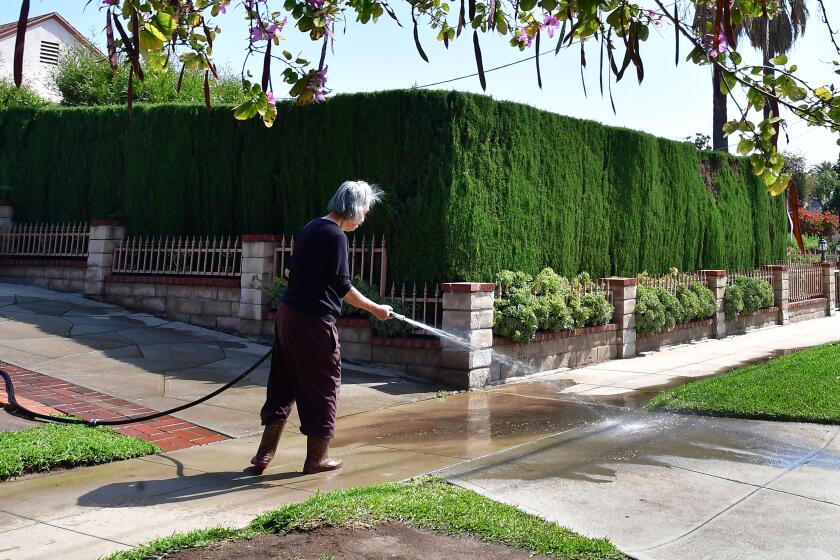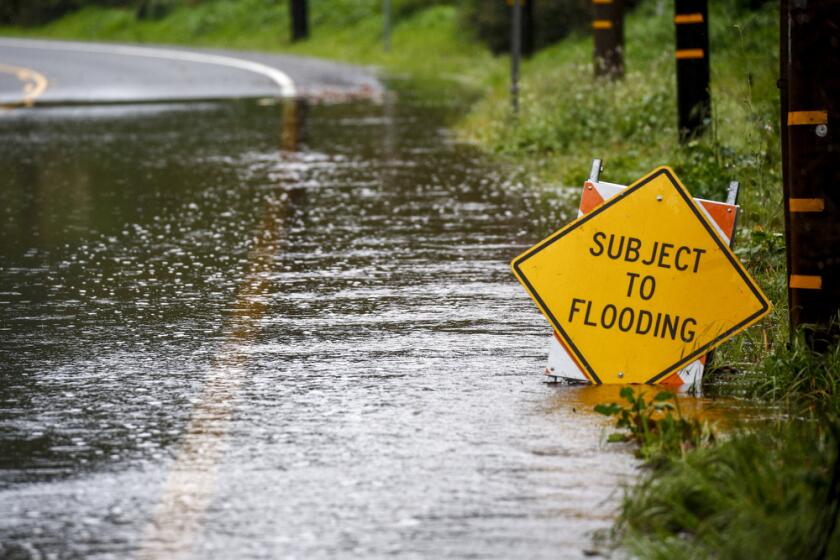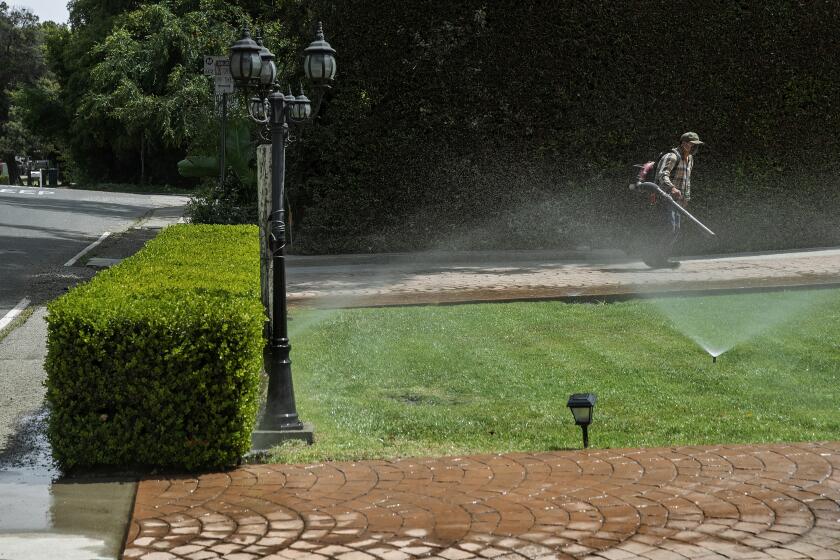To survive drought, parts of SoCal must cut water use by 35%. The new limit: 80 gallons a day

- Share via
When the Metropolitan Water District of Southern California this week unveiled its strictest-ever water restrictions for about 6 million residents, it did so with an urgent goal in mind: a 35% reduction in water consumption, equating to an allocation of about 80 gallons per person per day.
Officials said that’s the number needed to conserve critical supplies for health and safety amid worsening drought — and to prevent a full outdoor watering ban as soon as September. Currently, the average potable water use across the MWD’s service area — including residential, commercial and industrial water use — amounts to 125 gallons per person per day.
“The ballpark figure we’re looking at is getting to the consumption of about 80 gallons per person per day,” said Adel Hagekhalil, the district’s general manager. “We’re trying to preserve everything we can.”
The number is not arbitrary: Southern California communities that are dependent on water delivered from Northern California by the State Water Project normally demand about 380,000 acre-feet of water between June and December. (An acre-foot is about enough water to cover a football field to a depth of one foot.)
But the projected supply during the second half of this year is far less — only 250,000 acre-feet. Facing the real risk of those supplies running dry, the MWD’s managers say immediate cuts will help reserves last.
“We need to stretch the water because we can’t get any more water at this point” for these parts of Southern California, Hagekhalil said. “We’re saying the water we have available to us is the water that’s going to last us until the end of the year. And we want everyone to help.”
Reducing outdoor watering to one day a week is an effective way to reach the target, officials said. But what does 80 gallons per person look like, and what would it mean for the daily life of average Californians?
Large portions of Southern California are being told to water outdoors just one day a week. And a total watering ban could be imposed by fall.
For starters, more brown lawns are a given. Under the new rules, MWD will require suppliers to limit watering times on the one day when watering is allowed for each customer. The details will be left to each supplier, but some water agencies have already said sprinklers should run no more than 8 minutes.
That alone should achieve significant savings, since outdoor watering accounts for as much as 70% of residential use in the region, according to the MWD.
Inside the house, experts say, 80 gallons should be more than sufficient.
“Taking landscapes out of it, we could cut indoor water use to 35 gallons per person per day without changing behavior, just with efficient appliances,” said Peter Gleick, co-founder and president emeritus of the Pacific Institute, a water think tank in Oakland.
Gleick said toilets are among the biggest water-users inside the home, and older toilets can use as much as 6 gallons a flush. But newer, more high efficient models have reduced that number to less than 1.3 gallons.
“Without a doubt, every one of us in our homes could cut our per-person water use quite substantially,” he said. In fact, a report published earlier this month found that a host of existing technologies and standard practices could improve water efficiency in California by as much as 48%.
Those efficiency measures include fixing leaks in water pipes, replacing inefficient washing machines and toilets and replacing lawns with plants suited to California’s dry climate.
“There are two components to this,” Gleick said. “One is, what do we do in the short run by changing our behavior? The second is, what do we do in the long run by changing our appliances, and in particular our outdoor landscaping?”
Researchers say California’s cities have big potential to use water more efficiently while taking advantage of stormwater and recycled wastewater.
Part of the challenge facing water managers is that many people don’t have a clear sense of how much they use in a day. A 2014 study on the perceptions of water use found that people underestimated use by a factor of 2 on average, with large underestimates for high water-use activities.
The study’s author, Shahzeen Attari, said that’s why focusing the restrictions on a specific activity — outdoor watering — instead of a per-capita number makes sense from a policy perspective, at least for the time being.
“If I say you’re only allowed to use water on a particular day, on a Tuesday for example, then anyone who’s watering on Wednesday, Thursday or Friday, it’s easy to say you’re not in compliance,” said Attari, an associate professor at Indiana University in Bloomington. “But if I say you’re allowed to use 10 gallons any time during the week ... it’s really hard for me to know whether you’ve reached your quota or not.”
Many study participants also believed curtailment actions such as turning off the faucet while brushing their teeth were highly effective, when in fact “there are lots of other behaviors that are way more effective to decrease water use,” Attari said, including reducing outdoor watering, replacing grass with xeriscaping and changing flushing behaviors.
“Back in the day, it used to be, ‘If it’s yellow, let it mellow,’ so we could bring that back,” she said. “The social norms have shifted that your toilet should always be pristine and clean, but we’re literally taking clean water and flushing it down.”
Areas that get water from the Colorado River or other sources will be spared from restrictions, at least for now. The strategy has divided experts.
According to the MWD, the member agencies affected by the one-day-a-week watering rules will ultimately be responsible for staying within their allocation. They will also be required to submit an enforcement plan to the MWD. Those that don’t cut back enough will be charged $2,000 for every additional acre-foot of water.
Areas that rely heavily or entirely on the State Water Project range from Calabasas to Pacific Palisades, and from North Hollywood to El Monte.
MWD managers have calculated the allocation of about 80 gallons per person per day for these areas based on the available supplies. The figure includes 55 gallons per person per day that the state is delivering for “health and safety” purposes through the State Water Project, plus 25 gallons per person per day that the district has available in its system this year, Hagekhalil said.
The affected agencies include the Los Angeles Department of Water and Power, Calleguas Municipal Water District, Inland Empire Utilities Agency, Las Virgenes Municipal Water District, Three Valleys Municipal Water District and Upper San Gabriel Valley Municipal Water District.
Those agencies, which together serve millions of customers in Los Angeles, Ventura and San Bernardino counties, were selected for the cuts because they rely heavily or entirely on allocations from the State Water Project, for which allocations were slashed to just 5% this year after a record-dry January, February and March.
Ellen Cheng, a spokeswoman for the Los Angeles Department of Water and Power, said the agency has had Phase 2 water restrictions in place since before the previous drought, and noted that their customers average about 111 gallons per person per day.
Areas that have alternative water sources, such as the Colorado River, will be spared from the mandatory cuts for the time being. But the Colorado River is also facing a major shortage, and officials in those areas are similarly working on ways to conserve.
In Santa Monica, for example, overall water use is about 103 gallons per day, including commercial and other industries, while residential use is less than 80 gallons per day, said water resources manager Sunny Wang.
In Beverly Hills, which also receives Colorado River water and is not subject to the MWD’s latest cuts, residents use between 80 and 180 gallons per day “depending on weather conditions,” said Public Works Director Shana Epstein.
Other water suppliers in California are similarly responding to the drought with more stringent water-saving mandates. In the Bay Area, the East Bay Municipal Utility District this week ordered a mandatory 10% reduction in water use for its customers.
Hagekhalil stressed that people should save water however they can, not just by cutting outdoor watering but also by doing things like not refilling swimming pools, or using pool covers to prevent evaporation, as is already required under some local ordinances.
“This is a natural disaster, and we need to act as if it is like an earthquake or a flood or a hurricane. This is how we should treat this,” he said.
More to Read
Sign up for Essential California
The most important California stories and recommendations in your inbox every morning.
You may occasionally receive promotional content from the Los Angeles Times.


















